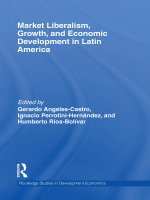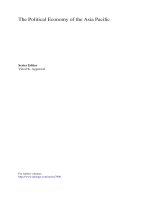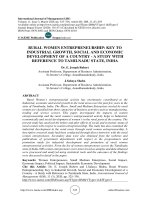Economic growth and economic development 368
Bạn đang xem bản rút gọn của tài liệu. Xem và tải ngay bản đầy đủ của tài liệu tại đây (76.87 KB, 1 trang )
Introduction to Modern Economic Growth
Differentiating this equation with respect to time, we obtain
q˙ (t) = φ00 (i (t)) i˙ (t) .
(7.61)
Substituting this into the second necessary condition, we obtain the following law
of motion for investment:
(7.62)
i˙ (t) =
1
[(r + δ) (1 + φ0 (i (t))) − f 0 (k (t))] .
φ (i (t))
00
A number of interesting economic features emerge from this equation. First, as φ00 (i)
tends to zero, it can be verified that i˙ (t) diverges, meaning that investment jumps
to a particular value. In other words, it can be shown that this value is such that
the capital stock immediately reaches its state-state value (see Exercise 7.22). This
is intuitive. As φ00 (i) tends to zero, φ0 (i) becomes linear. In this case, adjustment
costs simply increase the cost of investment linearly and do not create any need for
smoothing. In contrast, when φ00 (i (t)) > 0, there will be a motive for smoothing,
i˙ (t) will take a finite value, and investment will adjust slowly. Therefore, as claimed
above, adjustment costs lead to a smoother path of investment.
We can now analyze the behavior of investment and capital stock using the
differential equations (7.59) and (7.62). First, it can be verified easily that there
exists a unique steady-state solution with k > 0. This solution involves a level of
capital stock k∗ for the firm and investment just enough to replenish the depreciated
capital, i∗ = δk∗ . This steady-state level of capital satisfies the first-order condition
(corresponding to the right hand side of (7.62) being equal to zero):
f 0 (k∗ ) = (r + δ) (1 + φ0 (δk∗ )) .
This first-order condition differs from the standard “modified golden rule” condition,
which requires the marginal product of capital to be equal to the interest rate plus
the depreciation rate, because an additional cost of having a higher capital stock is
that there will have to be more investment to replenish depreciated capital. This is
captured by the term φ0 (δk∗ ). Since φ is strictly convex and f is strictly concave
and satisfies the Inada conditions (from Assumption 2), there exists a unique value
of k∗ that satisfies this condition.
354









